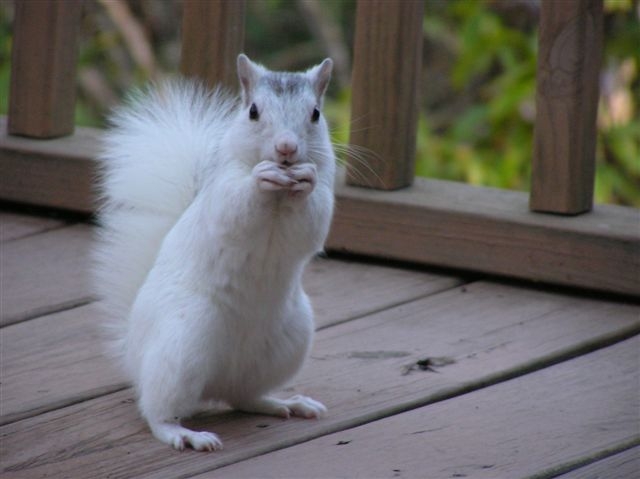
© Don Weiser
They're not as fearsome as a white whale on the high seas, or as portentous as a white buffalo calf on the Great Plains. But a handful of white squirrels is causing a stir in Maryland.
Two of the critters have been spotted scampering about between the historic Holly Hall Mansion and the Big Elk Mall in Elkton, chasing nuts and making headlines in the local newspaper.
"We all feed them, and they just kind of enjoy themselves, frolicking around in a little yard," said Elkton native Deborah L. Duff, who first noticed the young pair in September.
"They're like any typical squirrel," she said. "If you have enough peanuts, they'll come close, but not close enough to eat out of my hand."
Elkton's white squirrels are attracting gawkers, and the news has spurred other Marylanders to report similar sightings near Washington, D.C., and Easton.
Patricia Boynton spotted one in her backyard in Hyattsville, just outside the District line two weeks ago. "I was astonished to see it," the Texas native said. "I had no clue there were white squirrels up here."
The reports are trickling in to the White Squirrel Research Institute, in Brevard, N.C. The self-proclaimed "White Squirrel Capital of the World," Brevard hosts an annual White Squirrel Festival each May, and posts "white squirrel crossing" signs. The pale rodents make up a third of the local "gray" squirrel population.
Former Brevard College biologist Robert Glesener, founder of the institute, is the town's scientific spokesman. "From a scientific point of view, I don't think it's news," he said. "It's not something that's going to appear in [the science journals]
Nature, or
Science." But people seem to love furry white animals. Glesener gets two or three white squirrel reports a week from around the country. And communities like his are happy to cash in on their oddities.
Brevard's human population of 7,500 "probably doubles" during the White Squirrel Festival in May, he said. "They close the streets down, and they have vendors coming in."
The downtown White Squirrel Shoppe does a big business in squirrelly stuffed toys, license plates and bottled "white squirrel" water. And Glesener, sponsored by local businesses, takes visitors on squirrel tours.
A University of Maryland grad, Glesener is an ecologist and evolutionary biologist who moved to Brevard decades ago to study salamanders. But he found his students more motivated to study the white squirrels. They began with white squirrel counts (more than 1,000 now), and population maps (they range 50 to 80 miles around Brevard), and later conducted behavioral studies.
"Some people say they're more aggressive than gray squirrels, and some say they're more timid," Glesener said. "We have found that, other than coat color, there are no differences."
Some white squirrels, like Elkton's, are albinos, a genetic mutation characterized by a total lack of pigment, and pink eyes. But Glesener said that the Eastern gray squirrel (
Sciurus carolinensis) also exhibits a wide range of "normal" coloration, from white, through gray to black.
Black fur is thought to be a "thermal" adaptation, of particular benefit in colder latitudes, because black fur would absorb more solar heat. Black squirrels have been reported in some Maryland suburbs and on Kent Island.
Brevard's white
leucistic squirrels are descended from a pair captured in Florida and released in 1951. But Glesener believes the white color variants can and do occur anywhere. Many, including Brevard's, sport small patches of gray on their heads, backs and paws. They also have dark eyes.
Glesener said all gray squirrels have some white fur, usually confined to their bellies. He believes the white ones simply have a "regulator gene" that's "flipped," shifting the color pattern.
In Marionville, Mo., a local ordinance protects white squirrels with a $1,000 fine for killing one. In Elkton, Deborah Duff is feeling protective, too, she said, "because the local newspaper had to splash them across the front page. Now a lot of people are going there just to see them." She worries they'll be chased into nearby traffic.
In Brevard, Glesener said, "People tell me they will shoo the gray squirrels away from their [bird] feeders, but they'll let the white squirrels feed." Others say they brake for white squirrels, but not their brethren. "That's got to be a part of their success."
There are always more. Glesener's Web site counts 21 leucistic colonies in the range of the eastern gray squirrel, and nine persistent colonies of albino squirrels.
Beyond these, Glesener has recorded more than 70 "isolated sightings" of white squirrels. Some have come from Maryland observers in Bethesda, Essex and Queenstown. In 2002,
The Baltimore Sun reported on another pair of albino squirrels in Savage. They were named Sleet and Snow.
"Others say they brake for white squirrels, but not their brethren." This is too sick for even a bad racist joke. Why? "It'll make me like for work," What possible pleasure/pay off could be involved in deliberately hitting a squirrel when a tap on the brakes could avoid it? What is the payoff? Hey you driver--one day when you are the squirrel I hope you remember how worth it it was.
shellycheval